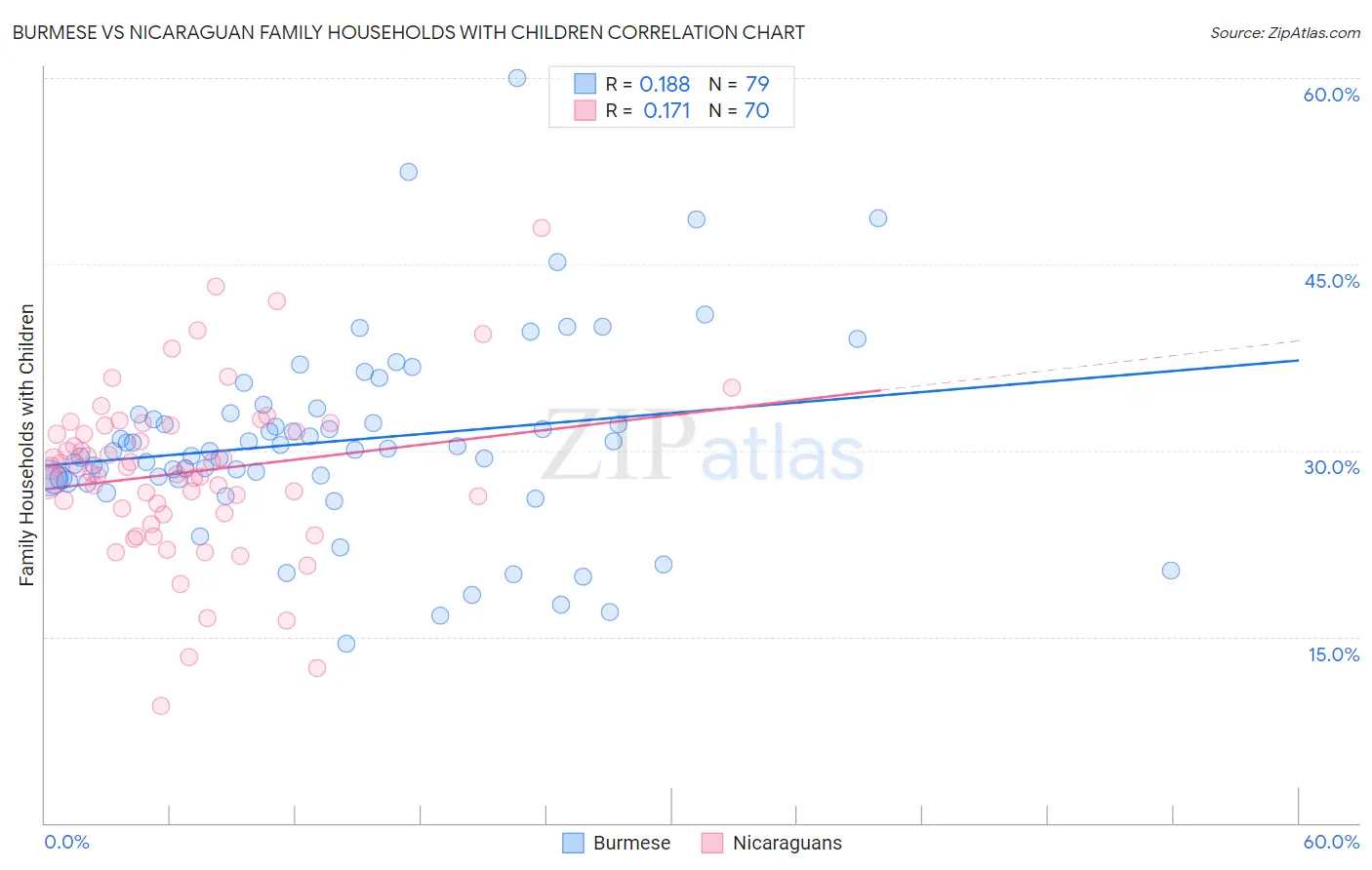Burmese vs Nicaraguan Family Households with Children
COMPARE
Burmese
Nicaraguan
Family Households with Children
Family Households with Children Comparison
Burmese
Nicaraguans
28.5%
FAMILY HOUSEHOLDS WITH CHILDREN
99.9/ 100
METRIC RATING
71st/ 347
METRIC RANK
28.4%
FAMILY HOUSEHOLDS WITH CHILDREN
99.8/ 100
METRIC RATING
83rd/ 347
METRIC RANK
Burmese vs Nicaraguan Family Households with Children Correlation Chart
The statistical analysis conducted on geographies consisting of 464,672,516 people shows a poor positive correlation between the proportion of Burmese and percentage of family households with children in the United States with a correlation coefficient (R) of 0.188 and weighted average of 28.5%. Similarly, the statistical analysis conducted on geographies consisting of 285,584,121 people shows a poor positive correlation between the proportion of Nicaraguans and percentage of family households with children in the United States with a correlation coefficient (R) of 0.171 and weighted average of 28.4%, a difference of 0.44%.

Family Households with Children Correlation Summary
| Measurement | Burmese | Nicaraguan |
| Minimum | 14.4% | 9.4% |
| Maximum | 60.0% | 47.9% |
| Range | 45.6% | 38.5% |
| Mean | 30.8% | 28.2% |
| Median | 30.1% | 28.5% |
| Interquartile 25% (IQ1) | 27.7% | 25.0% |
| Interquartile 75% (IQ3) | 33.0% | 32.0% |
| Interquartile Range (IQR) | 5.3% | 7.0% |
| Standard Deviation (Sample) | 7.8% | 6.7% |
| Standard Deviation (Population) | 7.8% | 6.7% |
Demographics Similar to Burmese and Nicaraguans by Family Households with Children
In terms of family households with children, the demographic groups most similar to Burmese are Immigrants from Honduras (28.5%, a difference of 0.010%), Immigrants from Indonesia (28.5%, a difference of 0.010%), Iraqi (28.5%, a difference of 0.040%), Laotian (28.5%, a difference of 0.060%), and Immigrants from Korea (28.5%, a difference of 0.070%). Similarly, the demographic groups most similar to Nicaraguans are Costa Rican (28.4%, a difference of 0.0%), Immigrants from Syria (28.4%, a difference of 0.020%), Kenyan (28.4%, a difference of 0.050%), South American (28.4%, a difference of 0.090%), and Native/Alaskan (28.4%, a difference of 0.12%).
| Demographics | Rating | Rank | Family Households with Children |
| Ghanaians | 99.9 /100 | #67 | Exceptional 28.5% |
| Houma | 99.9 /100 | #68 | Exceptional 28.5% |
| Immigrants | Korea | 99.9 /100 | #69 | Exceptional 28.5% |
| Immigrants | Honduras | 99.9 /100 | #70 | Exceptional 28.5% |
| Burmese | 99.9 /100 | #71 | Exceptional 28.5% |
| Immigrants | Indonesia | 99.9 /100 | #72 | Exceptional 28.5% |
| Iraqis | 99.9 /100 | #73 | Exceptional 28.5% |
| Laotians | 99.9 /100 | #74 | Exceptional 28.5% |
| Immigrants | Jordan | 99.9 /100 | #75 | Exceptional 28.4% |
| Immigrants | Sri Lanka | 99.9 /100 | #76 | Exceptional 28.4% |
| Nigerians | 99.8 /100 | #77 | Exceptional 28.4% |
| Immigrants | Nepal | 99.8 /100 | #78 | Exceptional 28.4% |
| Immigrants | Iraq | 99.8 /100 | #79 | Exceptional 28.4% |
| Natives/Alaskans | 99.8 /100 | #80 | Exceptional 28.4% |
| South Americans | 99.8 /100 | #81 | Exceptional 28.4% |
| Kenyans | 99.8 /100 | #82 | Exceptional 28.4% |
| Nicaraguans | 99.8 /100 | #83 | Exceptional 28.4% |
| Costa Ricans | 99.8 /100 | #84 | Exceptional 28.4% |
| Immigrants | Syria | 99.8 /100 | #85 | Exceptional 28.4% |
| Immigrants | Western Africa | 99.6 /100 | #86 | Exceptional 28.3% |
| Colombians | 99.6 /100 | #87 | Exceptional 28.3% |